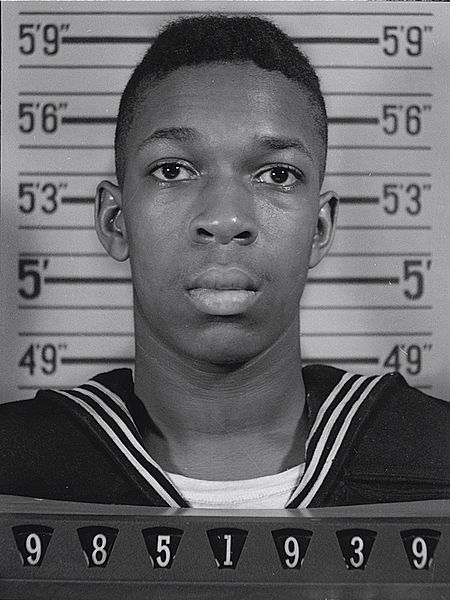Do you ever have déjà vu? Last week we posted Jack Kerouac’s U.S. Naval Reserve enlistment mugshot from 1943 and the response was enthusiastic. Many of you were fascinated to see the great Beat writer at such a tender age and in such an atypical, unliberated context. Today we offer an eerily similar photo of another freewheeling icon of 20th century art: John Coltrane, when he was 18 years old.
Coltrane entered the Navy on the same day the United States dropped the atomic bomb on Hiroshima (August 6, 1945) and was assigned reserve status, as were many African-Americans at that time. According to Lewis Porter in John Coltrane: His Life and Music, only limited numbers of black men served as seaman after 1942. Prior to that, they were only allowed to work as kitchen help. The Navy was segregated, and Coltrane was sent to boot camp at the black section of Sampson Naval Training Center in upstate New York. By the time he finished training, World War II was over.
In late November of 1945, after a transitional month at Camp Shoemaker near San Francisco, seaman second class Coltrane was assigned to active duty in Hawaii. Stationed on the island of Oahu, Coltrane played clarinet and alto saxophone in a black Navy band called the Melody Masters. He made his first recordings with some of the musicians from the band in the summer of 1946. But all the while Coltrane was serving, the Navy was in the process of downsizing. With the war over, bands were no longer needed to boost morale. So on August 11, 1946–just over a year after his enlistment–Coltrane was discharged from the Navy and sent home.
Related content:
John Coltrane and His Great Quintet Play ‘My Favorite Things’
John Coltrane Plays Only Live Performance of A Love Supreme
John Coltrane: Three Great European Performances, 1969, 1961 and 1965



Do you want to improve and develop your Saxophone skills? Now it’s vesy easy because here you will find high quality video sax lessons on demand. Just try the sax school.
cool!